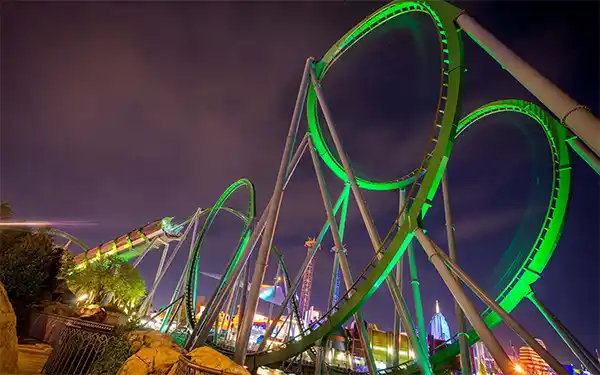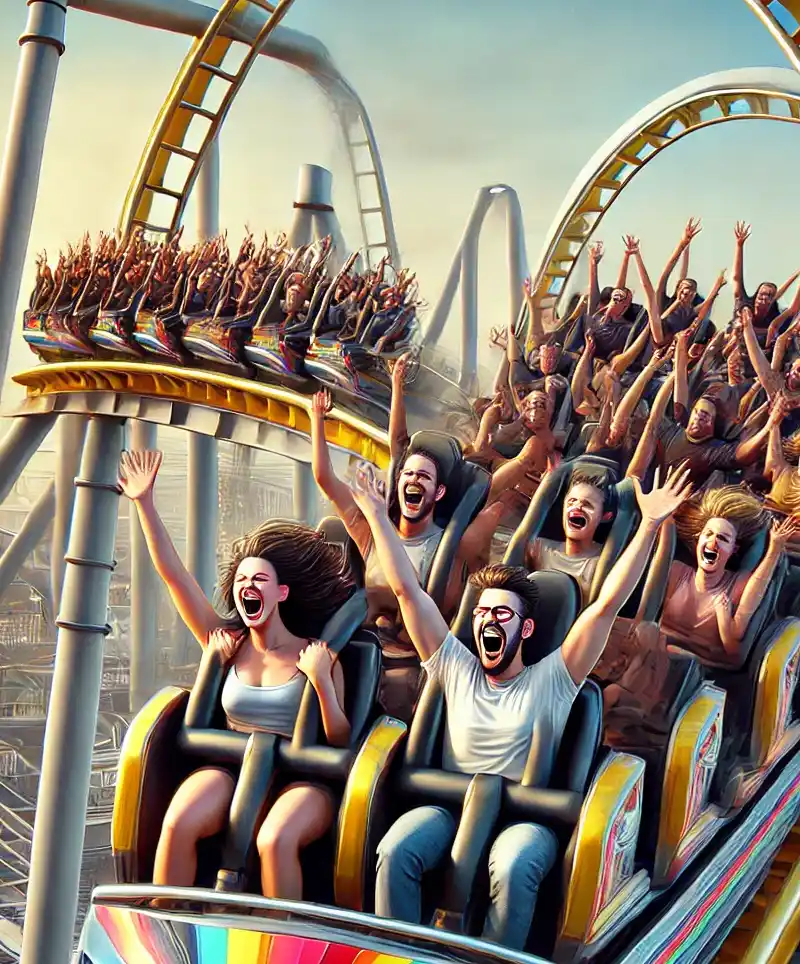A Wild Ride Through History, Physics, and Screams
Hold on tight, because August 16th is National Roller Coaster Day—a day dedicated to celebrating the ups, downs, twists, and turns of one of the most thrilling inventions known to humanity. Whether you're a seasoned thrill-seeker who lives for that stomach-dropping first hill or someone who thinks twice before getting on the kiddie coaster, this day is all about embracing the joy (and occasional terror) of the roller coaster.
The Birth of the Roller Coaster
Roller coasters have a history as winding and unpredictable as the rides themselves. The earliest versions of roller coasters can be traced back to 17th-century Russia, where ice slides were a popular winter activity. These early rides, known as "Russian Mountains," consisted of large wooden ramps covered in ice. Riders would slide down in sleds, feeling the exhilaration of speed and the wind whipping through their hair. No seat belts, no safety bars—just pure, unadulterated thrill, with a side of frostbite.
As the idea spread to warmer climates, the ice was replaced with wheels, and the modern roller coaster began to take shape. The first true roller coaster, as we know it today, was the Gravity Pleasure Switchback Railway, which opened in Coney Island, New York, in 1884. This early coaster was a far cry from the steel giants of today—it was a simple wooden track that reached a top speed of six miles per hour. But for the brave souls who rode it, it was an adventure like no other.
From there, roller coasters evolved rapidly, with engineers and thrill-seekers constantly pushing the boundaries of what was possible. The 1920s saw the Golden Age of roller coasters, with massive wooden structures like the Cyclone at Coney Island becoming icons of American amusement parks. These early coasters laid the groundwork for the gravity-defying, loop-the-looping, adrenaline-pumping rides we enjoy today.
The Physics of Fun
Ever wonder why you feel weightless at the top of a hill or why your stomach seems to do a backflip during a loop? It's all thanks to the marvels of physics. Roller coasters are essentially large, complex playgrounds for the laws of motion and energy.
At the heart of every roller coaster is the battle between potential and kinetic energy. As the coaster climbs that first hill, it's building up potential energy—like a spring being compressed. Once it reaches the top and starts the descent, that potential energy is converted into kinetic energy, sending the coaster speeding down the track. Gravity does most of the work, with the track layout determining the coaster's twists, turns, and loops.
 The feeling of weightlessness, known as "airtime," occurs when the coaster's speed and the downward force of gravity cancel each other out, leaving you momentarily free from the bonds of Earth. Meanwhile, the G-forces you experience during a loop or sharp turn are a result of inertia—your body's resistance to changes in motion. These forces can make you feel like you're being pushed into your seat (positive G-forces) or lifted out of it (negative G-forces), adding to the thrill of the ride.
The feeling of weightlessness, known as "airtime," occurs when the coaster's speed and the downward force of gravity cancel each other out, leaving you momentarily free from the bonds of Earth. Meanwhile, the G-forces you experience during a loop or sharp turn are a result of inertia—your body's resistance to changes in motion. These forces can make you feel like you're being pushed into your seat (positive G-forces) or lifted out of it (negative G-forces), adding to the thrill of the ride.
Of course, behind the fun is a lot of serious engineering. Roller coasters are designed with safety as the top priority, with extensive testing and precise calculations ensuring that every ride is both thrilling and secure. So, while it might feel like you're defying the laws of nature, rest assured that physics is on your side.
Roller Coasters Around the World
Roller coasters are a universal language of fun, with rides in nearly every corner of the globe. From the towering steel giants in the United States to the inventive and quirky coasters in Japan, there's a roller coaster out there for everyone.
- The United States: Home to some of the most iconic coasters in the world, including Kingda Ka at Six Flags Great Adventure in New Jersey, the tallest coaster in the world. The U.S. also boasts Cedar Point in Ohio, known as the “Roller Coaster Capital of the World” with a collection of 17 coasters, each offering a unique thrill.
- Japan: Known for pushing the limits of creativity, Japan is home to rides like the Eejanaika at Fuji-Q Highland, which features seats that rotate 360 degrees, giving you a new perspective (or maybe just a headache) with every twist.
- Germany: The birthplace of some of the most technologically advanced coasters, Germany’s Europa-Park features the Silver Star, a hypercoaster that gives riders the feeling of free-falling from a skyscraper.
- The United Arab Emirates: Not to be outdone, Ferrari World in Abu Dhabi is home to Formula Rossa, the fastest roller coaster in the world, reaching speeds of 149 miles per hour. It’s like driving a Ferrari—if the Ferrari was strapped to a rocket and sent hurtling through the air.
Fun Facts
- The Longest Roller Coaster: Steel Dragon 2000 in Japan holds the record for the longest roller coaster in the world, stretching an incredible 8,133 feet. That’s nearly a mile and a half of twists, turns, and sheer excitement.
- The Oldest Operating Roller Coaster: The Scenic Railway at Luna Park in Melbourne, Australia, opened in 1912 and still thrills riders today. It’s not just a ride; it’s a piece of history.
- The First Inversion: The first roller coaster to turn riders upside down was the Flip Flap Railway at Coney Island, which debuted in 1895. It was so intense that it was eventually shut down for being too dangerous—proving that even thrill-seekers have their limits.
- Roller Coaster Marathons: Some people love roller coasters so much that they compete in marathon riding sessions, spending hours—sometimes days—riding the same coaster over and over. The world record for the longest marathon on a roller coaster is over 405 hours!
Get Your Scream On
National Roller Coaster Day is the perfect excuse to let your inner thrill-seeker run wild. Whether you're hitting up your local amusement park or just reminiscing about your favorite rides, this day is all about celebrating the joy of roller coasters.
- Do: Take a ride on a roller coaster you’ve never tried before. If you’re feeling adventurous, go for the one that makes your palms sweat just thinking about it.
- Don’t: Eat a giant meal right before hopping on a coaster. Trust us—gravity plus a full stomach equals a bad time for everyone involved.
- Do: Share your roller coaster experiences with friends and family. Whether it’s the time you screamed your head off or when you couldn’t stop laughing, those memories are worth reliving.
- Don’t: Forget to check your safety harness. As much as we love the thrill, safety always comes first!
In many ways, life is a lot like a roller coaster. It’s full of ups and downs, moments of calm, and unexpected twists. But no matter how wild the ride gets, the important thing is to hold on, enjoy the journey, and maybe even throw your hands up in the air once in a while. So, on National Roller Coaster Day, let’s celebrate the thrill of the ride—both on the tracks and in life. After all, it’s not about how many loops you go through; it’s about how much fun you have along the way.
Please Share our Content






 The feeling of weightlessness, known as "airtime," occurs when the coaster's speed and the downward force of gravity cancel each other out, leaving you momentarily free from the bonds of Earth. Meanwhile, the G-forces you experience during a loop or sharp turn are a result of inertia—your body's resistance to changes in motion. These forces can make you feel like you're being pushed into your seat (positive G-forces) or lifted out of it (negative G-forces), adding to the thrill of the ride.
The feeling of weightlessness, known as "airtime," occurs when the coaster's speed and the downward force of gravity cancel each other out, leaving you momentarily free from the bonds of Earth. Meanwhile, the G-forces you experience during a loop or sharp turn are a result of inertia—your body's resistance to changes in motion. These forces can make you feel like you're being pushed into your seat (positive G-forces) or lifted out of it (negative G-forces), adding to the thrill of the ride.








 "Sláinte!" is a traditional Irish expression used as a toast, equivalent to "Cheers!" in English.
"Sláinte!" is a traditional Irish expression used as a toast, equivalent to "Cheers!" in English.